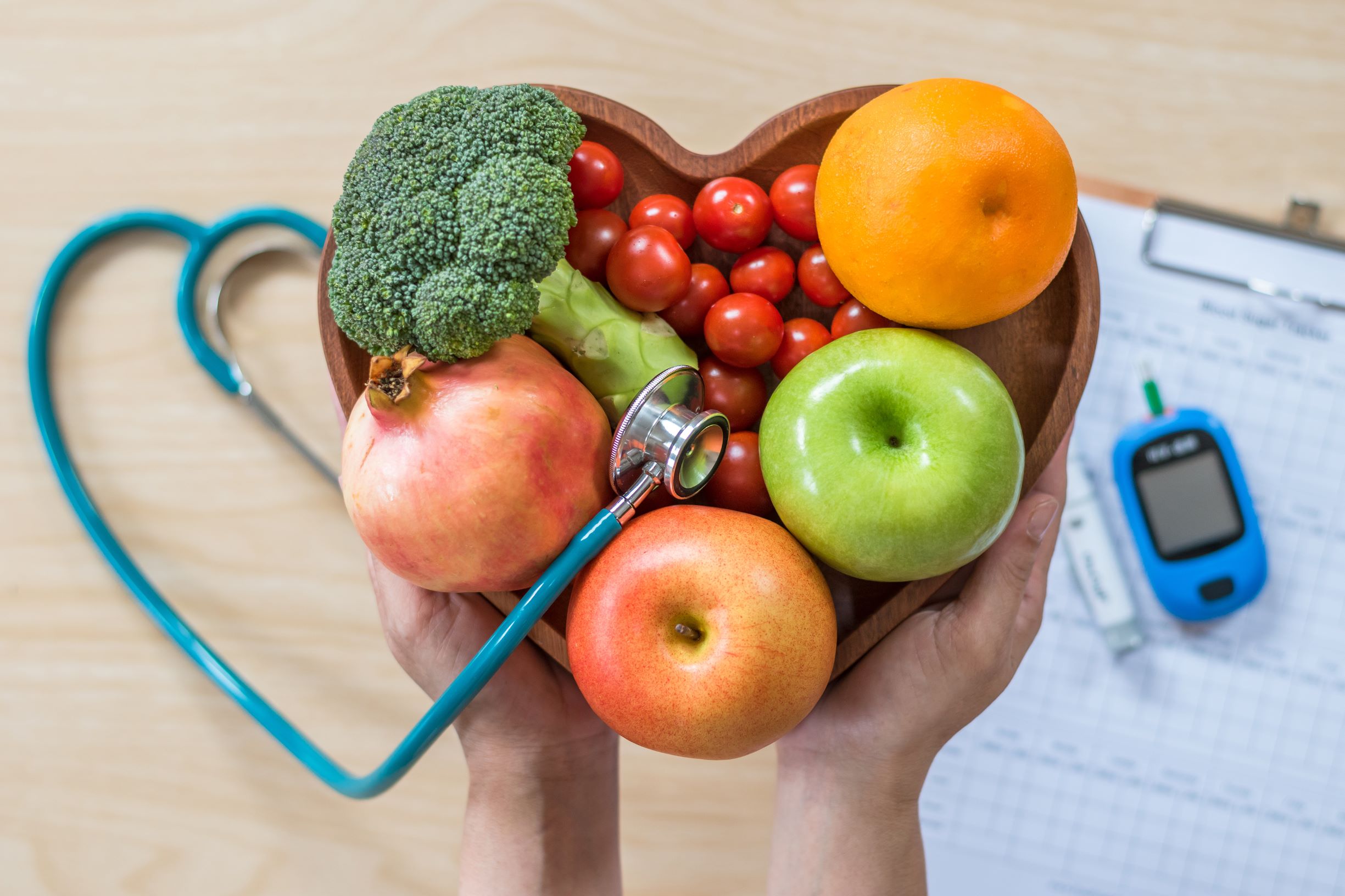Author: Brandon Boyd
Keep Your New Years Resolutions Beyond January
Every New Years, we create resolutions in hopes of improving our health or making positive changes to our lives. Often our resolutions, while well-meaning, don’t last beyond the month of January. Deciding to improve one’s health is a good first step. Follow our tips below to ensure your resolutions stick well beyond this month.
Avoid a fad diet
Fad diets have gained large popularity over the last few years. Celebrities often use their platforms to market these diets and products. Unfortunately, a fad diet’s success is just that – a short lived fad. No one wants to see their hard work and progress go right down the drain. Some popular fad diets include: the Keto diet, the Carnivore diet, and any diet labeled with “detox” or “cleanse”. These diets can be very restrictive of the nutrients that your body needs. There are some lifestyle diets, however, that emphasize balancing macronutrients and are more suitable to follow long term. These include the DASH diet and the Mediterranean Diet. If a diet fits into your lifestyle make sure to speak with a Registered Dietitian so they can help you successfully achieve your goals without compromising your health.
Subtle modifications
Instead of drastic diet modifications make subtle changes that alter your lifestyle without making major changes. These changes should take into consideration not having a substantial effect on your schedule or finances to avoid any extra work on your part. For example, make meatloaf with half ground beef and half ground turkey. Want to take it up a notch? Add a cup of spinach into your meatloaf for a tasty layer of greens in the middle. Simple swaps can work with various type of meals and recipes. Find an idea and make it your own!
Never underestimate the power of veggies!
Veggies are not only colorful, but nutrient dense foods that are packed with vitamins, minerals, and fiber. Vitamins and minerals help boost the immune system while fiber helps to regulate bowel function and lower your cholesterol. Consuming the recommended amount of vegetables daily has also been shown to reduce the risk of developing chronic illnesses such as: diabetes, heart disease, and certain cancers. The recommended intake for vegetables is 2 to 3 cups per day. Color your New Year, by following some of these tips to help increase your daily vegetable intake:
- Add vegetables into sauces – This can include pureeing butternut squash into your homemade mac n’ cheese or chopping up mushrooms, peppers, and spinach to your tomato based sauce
- Replace pasta with your favorite vegetable – Spiralizers are all the craze, but all you need is a standard peeler to use on summer squash to make long noodle-like strands. Cook with crushed tomatoes, a lean meat, and your favorite seasonings. If labor is a concern, spaghetti squash is also an option. To prepare cut the squash in half, lightly drizzle olive oil, sprinkle pepper, and garlic powder, and cook in the oven at 375° for 40 minutes. Dish it onto your plate and top with turkey meatballs, and another colorful vegetable of your choice
- Sneak vegetables into your favorite dinner meal – It is easy to add vegetables into a lean ground meat. Doing this not only increases the nutrients, but also helps moisten the meat and add additional flavor to the meal. Some examples include: adding a half cup of peeled zucchini and carrots into a ground turkey or lean beef mixture and use for meatloaf, meatballs, or lasagna. Adding additional vegetables like mushrooms and chopped eggplant are especially delicious in a lasagna. You can also spice up your next burger by adding diced mushrooms and spinach. The choices are endless!
Healthy Twist on Taco Rice

Makes ~4 servings
1/2 cup uncooked rice
1 cup frozen cauliflower rice (may thaw for quicker cooking)
Half onion ( approx. ¼ c chopped)
1-2 tablespoon olive oil
1 tablespoon low sodium taco seasoning (or use ¼ tsp of each: cumin, chilli powder, garlic powder)
Choice of low sodium broth (vegetables, chicken, beef etc.)
¾ cup canned beans ( pinto, black beans etc)
1 medium tomato diced optional
½ avocado diced optional
½ c shredded cheese optional
1. Prepare rice according to directions but substitute half of the water with your choice of broth and under-cook by 2 mins.
2. While the rice is cooking sauté onion on low-med heat with 1-2 tbsp olive oil until translucent approximately 8 mins
3. Add cauliflower rice to pan, cover and cook through for ~ 4-8 minutes
4. Combine cauliflower/onion mix into pot with rice
5. Add taco seasoning and beans, cook over low heat covered for an additional 5 minutes
6. Top with optional toppings if desired and Enjoy!
This can be paired as a side with an entrée or topped with grilled chicken, shrimp or tofu along with a side salad for a complete meal.
January Energy Tip from NRG
RESOLVE TO BE MORE ENERGY EFFICIENT IN 2019
When making new year’s resolutions, people probably don’t think about using less energy in their home. But using less energy can benefit not just you, but your neighbors, your town, the entire grid.
- Use LED lights when possible. According to the Energy Department, residential LEDs — especially ENERGY STAR rated products — use at least 75% less energy, and last 25 times longer, than incandescent lighting. The investment you make now will more than pay off over the long term.
- Check your air vents regularly. The air in your home should be distributed effectively. If something is obstructing the vents, it can make the system work harder, thus using more energy.
- Weather strip around your doors and windows. Stop heat from escaping during by sealing any cracks and holes that might exist. You’d be amazed at the amount of heat that’s lost via small cracks and holes.
- When making major purchases of appliances in the new year, be sure to get energy star rated appliances. They can bring you big savings over the lifetime of the appliance.
- Use an electronic power strip for all your electronics like TVs, desktops, cable box, etc. That way, you turn off all appliances by turning off just one device.
- Lower your thermostat. Better yet, consider getting a Smart Thermostat.
If possible set your thermostat to no warmer than 68°F! The U.S. Department of Energy says you could save about 1% on heating usage for every degree you lower your thermostat over an eight-hour period. Even 70 instead of 72 can make a difference.
- In winter, keep your blinds open during the day to let the sun heat your home naturally. It’s the opposite during the summer. Close your curtains during the day to prevent the sun from making your home even warmer, making your A/C work even harder.
BONUS TIP: One thing to also consider. Pennsylvania and New Jersey are electricity choice states, which means consumers don’t have to settle for the one price fits all the utilities offer. People have a lot of choices. Many companies, like NRG, offer a variety of electricity plans that suit a family’s lifestyle and electricity usage, including fixed price plans that allow customers to lock-in their supply price for a set period, which can protect them from potential unpredictable energy price hikes due to heat waves, cold snaps, and other factors. Some plans offer you renewable energy, which can basically offer many of the benefits of solar or wind, without having solar panels on your roof.
Be Healthful at the Holidays
What do you think of when you think about the holidays? You probably think of family, friends, presents, but most of the time the holidays are associated with an abundance of delicious foods. Keeping a healthful diet can be challenging during the holidays; studies have even shown that the average American gains approximately three to five pounds during the winter months due to the holidays. It might not sound like a lot, but these pounds tend to be the ones that stick throughout the rest of the year. It is important to be aware of some small healthful changes that can easily be made to your holiday meals and to keep mindful eating in your thoughts. Some helpful tips when cooking during the holidays include reducing the fat, sugar, and salt, while increasing the fiber to some of your favorite holiday dishes.
Reduce fat:
To reduce some of the fat content, try reducing the added fat by half or using a substitute for the remaining half such as applesauce or banana when baking. When choosing sour cream or milk at the grocery store, opt for the low-fat versions. Skimming excess fat from the top of gravies and draining excess fat from cooked meats are simple ways to cut down on fat as well.
Reduce sugar:
Reducing the amount of sugar can also be as simple as adding about ¼ cup less sugar and adding extra spices to your favorite baked good recipe.
Reduce salt:
If you use canned or frozen vegetables for cooking, choose vegetables with no added salt or rinse the vegetables before cooking to remove some of the excess salt. When using store-bought broth or soup, make sure to purchase a low-sodium or no salt version and add salt to your own desire.
Increase fiber:
To increase fiber and other nutrients, try switching out refined flours with whole-wheat flours such as brown rice, whole-wheat bread, whole-wheat pasta, or oatmeal. Vegetables and fruits also provide fiber and can be added to dishes like chili, spaghetti sauce, casseroles, stews, salads, muffins, and desserts.
Healthier cooking techniques:
When cooking your holiday meals, use healthier cooking techniques that will help reduce the fat content such as nonstick pans, baking, grilling, or poaching.
Mini Pumpkin Spice Oatmeal Muffins

National Diabetes Month
The month of November is American Diabetes Month. Diabetes is a disease that occurs when the pancreas cannot produce enough insulin to lower the sugar levels in your bloodstream. If these sugars build up, they can cause serious health problems down the road. Currently, 30.3 million people in the United States have diabetes with type 2 diabetes being the most common. One out of ten Americans are living with diabetes, and one in four do not even know they have it. Therefore, being aware of the symptoms and risk factors for diabetes is crucial. Some of the symptoms of type 2 diabetes include: blurred vision, numbness in the hands or feet, sores that do not heal, unexplained weight loss, and increased thirst, urination, or hunger. However, these symptoms are not always present. The risk factors that increase your chances of developing type 2 diabetes are an age of 45 or older, a family history of type 2 diabetes, a weight status of overweight or obese, and a medical history of heart disease, stroke, or hypertension.
The health factors associated with type 2 diabetes are called the ABCs of diabetes:
- A1c: Your A1c is the average amount of sugar in your blood over the past 2-3 months. An A1c >5.7% indicates prediabetes, or a condition that puts you at a higher risk for developing diabetes. An A1c of >6.5% indicates diabetes.
- Blood pressure: Your blood pressure is a measurement of how blood flows through your veins. A blood pressure greater than 130/80 is high.
- Cholesterol: Your cholesterol is split into two categories: HDL, which is good cholesterol, and LDL, which is bad cholesterol. A value over 100 for LDL means high cholesterol. This can be from an unhealthy diet, not enough exercise, or smoking.
Be sure to discuss your A1c, blood pressure, and cholesterol with you doctor to take the appropriate measures.
If you have multiple risk factors, have prediabetes, or have diabetes, it is important to properly manage your conditions to avoid health complications. Following a healthful, balanced diet with portioned carbohydrates and sugars will help keep your diabetes in check. Carbohydrates are one of the three main energy sources in food. The other two sources are protein and fat. Some sources of carbohydrates include: bread, pasta, rice, starchy vegetables, fruits, milk, and yogurt. Carbohydrates are transformed into glucose when digested and exist in your blood stream as blood sugar. When planning meals at home, try to portion out the carbohydrate foods you eat. A rule of thumb is to make 25% of your plate carbohydrates such as corn, sweet potatoes, rice, pasta, or tortillas. Another 25% of your plate should be lean protein such as beans, fish, eggs, chicken, or turkey, and the remaining 50% should be non-starchy vegetables such a: carrots, cabbage, broccoli, tomatoes, peppers, or collard greens. Along with keeping a balanced diet, those at risk or those with diabetes should also try to exercise at least three times per week, take prescribed medications, maintain a healthy weight, and check blood sugars as directed by their doctor.

Cauliflower Rice
Ingredients:
1 large head cauliflower, separated in to florets
3 tbsp. olive oil
1 medium onion, diced
Dash of salt
2 tbsp. fresh parsley
Juice of ½ lemon
Directions:
- Break up the cauliflower florets and pulse in a food processor until the mixture resembles a crumble.
- Heat oil in a large skillet.
- Add the onions and stir.
- Cook onions for about 8 minutes, until golden brown.
- Add cauliflower to skillet and stir.
- Add 1 tsp. salt and stir frequently.
- Cook for about 3-5 minutes until cauliflower is softened.
- Remove from skillet.
- Spoon cauliflower mixture into a large bowl.
- Garnish with parsley and lemon juice.
- Add salt to taste.
- Enjoy!
Eat Better, Eat Together Month
Eating together as a family may be more important than you think. There are many benefits to eating with your family, so why not start now for October’s National Eat Better, Eat Together Month? Some of the benefits you will see include: improved relationships and connections, better nutrition, an opportunity to teach children about portion sizes and healthy foods, and a place for children to practice their social skills. Children with families who eat together are more likely to snack on healthy foods versus unhealthy foods. They are also more likely to do better in school and have improved behavioral traits. Finding the time to sit down together as a family to eat can sometimes be a challenge, but it is a well worth it one!
Some tips to make eating together as a family a priority are scheduling meals, preparing meals beforehand, and making a simple meal. When scheduling meals, make sure to check the calendar so the entire family can join for the meal. If you are a part of a busy family, try setting a goal of one or two family meals per week at first. To help save time, complete some of the food preparation another time when you are not so busy to help take the stress off cooking a meal from start to finish in one sitting. You could even cook a complete meal and freeze it for later in the week! Just remember, these meals do not need to be super fancy either – just nutritious and delicious!
Ways to Involve Your Kids:
- Ask for ideas when making a grocery list
- Take children to the grocery store with you to help them pick out foods and educate them on picking healthier options
- Have them help set the table and turn off the TV to prepare for the family meal
- When cooking, children can help rinse vegetables, add ingredients to the bowl, or mix the ingredients
- It is important that children find family meals enjoyable, so always keep it fun in the kitchen!

Recipe for Wraps
Ingredients (1 serving):
1 8- to 10-inch whole wheat tortilla
1-2 T. dressing (i.e. low-fat mayonnaise, salsa, guacamole, hummus)
½ cup of your favorite vegetables
¼ cup of your favorite protein
1-2 T. shredded cheese
Directions:
- Heat the tortilla in the microwave or in a hot pan.
- Mix all of the filler ingredients in a bowl.
- Spread the filler ingredients onto the tortilla.
- Leave a 1-inch margin around the edge of the tortilla.
- Roll up the tortilla.
- Enjoy!
Tip #1: To help keep the wrap held together, wrap it in tin foil or plastic wrap.
Tip #2: If you are preparing the wrap for a later meal, begin layering with a leafy base to avoid a soggy tortilla.







